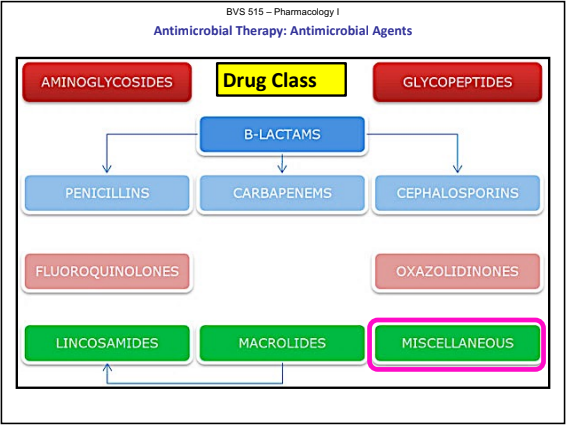39. Antimicrobial Therapy: Antimicrobial Agents 1
1/10
There's no tags or description
Looks like no tags are added yet.
Name | Mastery | Learn | Test | Matching | Spaced |
|---|
No study sessions yet.
11 Terms
Mechanism of Antibotics
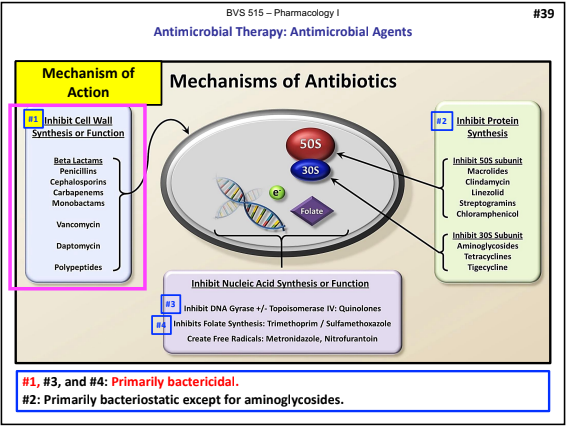
Cell Wall Inhibitors (Primarily bactericidal)
Referred to as beta-lactams or beta-lactam antibiotics due to the beta-lactam ring in their chemical structure. (A beta-lactam ring is a four-membered ring)
Penicillins
Cephalosporins
Vancomycin (Glycopeptide)
Polymyxins (Polymyxin B and Colistin= Polypeptides)
Bacitracin (Polypeptides)
Cell Wall Inhibitors
Cell wall inhibitors selectively interfere with the synthesis of the bacterial cell wall.
The cell wall is composed of a polymer called peptidoglycan and the final step in bacterial cell wall synthesis is a cross-linking of adjacent peptidoglycan strands by a process called transpeptidation.
Penicillins and cephalosporins bind to the enzymes that catalyze transpeptidation, penicillin binding proteins (PBPs), which weakens the cell wall causing it to burst or lyse (= cell death)
The cell wall is a structure that mammalian cells do not possess.
Inhibitors of cell wall synthesis require actively proliferating microorganisms to be effective
Antimicrobial Terminology

Cell Wall Inhibitors: Penicillins
Mechanism of Action
Inhibits bacterial cell wall synthesis by binding to one or more of the penicillin-binding proteins (PBPs).
Binding to penicillin-binding proteins inhibits the final transpeptidation step of peptidoglycan synthesis in bacterial cell walls inhibiting cell wall biosynthesis.
Bactericidal
Adverse Effects
Caution in patients with history of allergy to penicillins
GI effects (oral use) include nausea, vomiting, and diarrhea.
Allergic reactions are common side effects
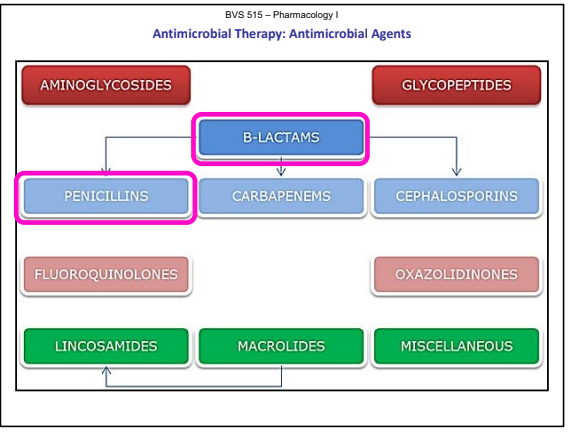
Cell Wall Inhibitors: Penicillins (Oral)
Mechanism of Action
Inhibits bacterial cell wall synthesis by binding to one or more of the penicillin-binding proteins (PBPs).
Binding to penicillin-binding proteins inhibits the final transpeptidation step of peptidoglycan synthesis in bacterial cell walls inhibiting cell wall biosynthesis.
Adverse Effects
Caution in patients with history of allergy to penicillins
GI effects (oral use) include nausea, vomiting, and diarrhea.
Allergic reactions are common side effects,
Ampicillin and Amoxicillin
Considered extended spectrum penicillins in relation to original penicillin G.
Susceptible to inactivation by beta-lactamases.
Formulated with a beta-lactamase inhibitor.
Amoxicillin with clavulanate (Augmentin®)
Not effective against Pseudomonas.
Dicloxacillin
Considered an anti-staphylococcal penicillin or beta-lactamase resistant penicillin.
Indicated to treat methicillin sensitive Staphylococcus aureus (MSSA).
NOT indicated to treat methicillin-resistant Staphylococcus aureus (= MRSA).
Amoxicillin + Clavulanic Acid (Augmentin®)
The addition of a beta-lactamase inhibitor (clavulanic acid) to amoxicillin makes it an extended spectrum penicillin in relation to original penicillin G.
Clavulanic acid, has no killing action or principal effect of its own.
Not effective against Pseudomonas.
Cell Wall Inhibitors: Cephalosporins (Oral)
Mechanism of Action: Inhibits bacterial cell wall synthesis similar to penicillins.
Bactericidal.
Cephalosporins are β-lactam antibiotics
are more resistant to certain β-lactamases than the penicillins
Cephalosporins are classified by generation (1st, 2nd, 3rd, 4th)
1st: Cephalexin
2nd: Cefuroxime
3rd: Cefdinir
ineffective against MRSA
general changes in coverage or spectrum of activity from first-generation through third-generation
Somewhat less gram-positive coverage to pick up broader gram-negative coverage
Adverse Effects
similar to the penicillins, but allergic reactions are also a concern
Patients who have had an anaphylactic response, Stevens-Johnson syndrome, or toxic epidermal necrolysis to penicillins should not receive cephalosporins.
GI effects such as nausea, vomiting, and diarrhea
Cephalosporins should be avoided or used with caution in individuals with penicillin allergy
Current data suggests cross-reactivity between penicillin and cephalosporins is ~ 3% to 5%
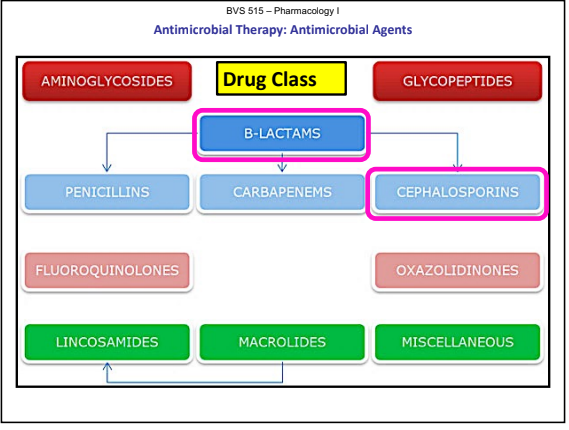
Vancomycin (Glycopeptide) (Compounded Topical Solution) (Oral or Injectable)
Mechanism of Action: Inhibits bacterial cell wall synthesis
Bactericidal.
A glycopeptide antibiotic used intravenously to treat methicillin-resistant Staphylococcus aureus (MRSA).
Vancomycin is not absorbed orally so the use of the oral form is for the treatment of C. difficile-associated diarrhea (CDAD).
Primarily active against gram-positive bacteria
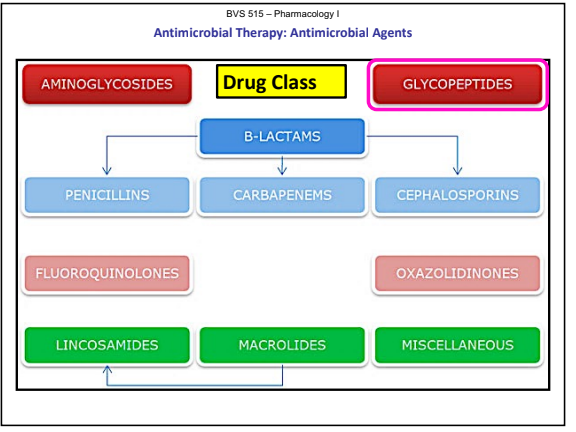
Polymyxins (Polymyxin B and Colistin = Polypeptides) (Topical Ointment, Compounded Topical Solution) (Injectable)
Mechanism of Action: Binds to phospholipids on the cell membrane of gram-negative bacteria ,damages the bacterial cytoplasmic membrane
Bactericidal
Polymyxins are cation polypeptides that have a detergent-like effect.
They have activity against most clinically important gram-negative bacteria, resistance is a concern.
Polymyxin B has multiple black box warnings
Only two forms of polymyxin are in clinical use today, polymyxin B and colistin (polymyxin E).
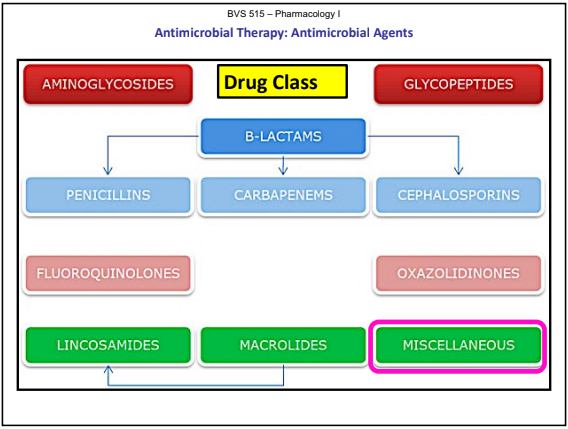
Bacitracin (Polypeptides) (Topical Ointment) (Injectable)
Mechanism of Action: Inhibits bacterial cell wall synthesis
Bactericidal.
Bacitracin is a mixture of related cyclic polypeptides interfering with cell wall synthesis, “cidal”.
black box warning of nephrotoxicity.
